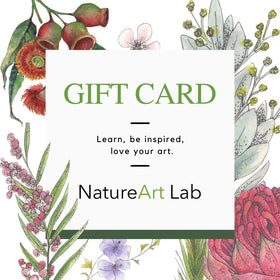
Trip to Atherton Tablelands and Kutini Payamu National Park, Cape York - 1 to 17 May 2020 - by Julie Lyne
The trip started on the official first day of the dry season 2020 after what had been a very damp wet season in the Australian tropics and looking back, amazingly the Queensland borders were still open for travel. It became very apparent, very quickly, that travelling with Nature Art Lab was going to give me a far richer experience than my usual independent travel.
It was a trip of two parts. Touring the wonderful and more accessible Atherton Tablelands was a great way to introduce everyone to Northern Queensland and let those of us who had not experienced the tropics acclimatise. Over the first week some of the sites we travelled to included Mount Hypipamee (a favourite), circumnavigated Lakes Eacham and Barrine and travelled to the drier country near Mareeba and Hasties Swamp. Travelling routines were quickly and easily established and our destinations had been chosen with great care. Dr Timothee Bonnet, Dr Damien Esquerre and Alan Landford were such enthusiastic and knowledgeable guides, their commentary providing us with a much greater appreciation of the ecology and behaviours of the individual species that we saw. No wildlife was left unidentified and for many of us the number of first time sightings of species was very high! One of the great opportunities of this trip gave was provided by Damien and Timothee who were able to locate and identify many tropical snakes and other reptiles for us to safely view and appreciate.
The second part of the trip started with a flight in to Lockhart River from Cairns which allowed us to appreciate the extraordinary extent and remoteness of the Cape and its rivers and the plains. As some of the first dry season travelers to arrive in the community, we experienced the area around Lockhart River when there were fewer travelers and this gave us many opportunities to search for wildlife such as the Eclectus parrot (which was easier heard than seen). One really special moment on the trip was meeting some of the Lockhart River Community artists and we were privileged to view their artworks and hear the stories. Another highlight was viewing the mangroves and the amazing birdlife from the water by boat as we travelled down the Lockhart River.
Each day of the trip there were many opportunities to see and appreciate the richness and diversity of species in the rainforest. Early morning bird chorus walks, day excursions, and night time spotlighting in the intense dark of the forest gave everyone the opportunity to experience the great diversity that the landscape offered. In our group, there were bird watchers, herpetologists, photographers, artists and those just interested in seeing everything! For those documenting the scenery by film or on paper through nature journaling there were waterfalls, granite boulders, wetlands, tall trees, many flowering plants and interesting seeds and fruits crater lakes, steep mountains, wild rivers and the ocean to try to capture.
But many of us came for the opportunity to observe the wildlife too. Whilst I will not list everything we saw - here is a tiny taste - from insects as beautiful as the Cairns Birdwing butterflies to giant stick insects and land snails, 100’s of birds from the tiniest fern wrens to the Southern Cassowary, from leaf tailed geckos to Boyd's forest dragon, green tree frogs, saw shelled turtles to crocodile tracks, platypus to northern spotted quoll and cus cus and my unexpected favourite - possums, striped, coppery brushtail, Herbert River, and green!
There were many truly amazing moments, the highlights included, striped possums feeding at Chambers Wildlife Rainforest Lodge, a waterfall frog at Davies Creek National Park, Amethystine Pythons at Julatten, a giant Daintree crayfish emerging from its creek side burrow in the Daintree forest, watching Palm Cockatoos feeding on beach almonds at Quintell Beach, Southern Cassowaries at Etty Beach, watching the spectacled flying fox fly out one evening from their roosts at Tolga, spending time at the Curtain Fig tree and seeing my first tree kangaroo, walking in the cool on Mt Lewis looking for blue faced finches but finding Chowchillas instead!
Sadly the trip also revealed that these special places were threatened. Cane toads were a common sighting, in the Atherton Tablelands precious slivers of rainforest were surrounded by towns and roads, making the movement of wildlife between these remnants a dangerous trip. In far north Queensland some of the beaches and the sea life were at risk from the enormous amounts of rubbish brought in on the tides. If you have the opportunity to assist protect these beautiful wild places I would encourage you to do so.
Seventeen days just flew by and it ended all too soon. My greatest thanks to Julia and her team for such a wonderful trip.
Image: Tree python photography, Dr Damien Esquerre; Nature Journaling page, Julie Lyne; Cape York landscape photography, Julia Landford




Leave a comment